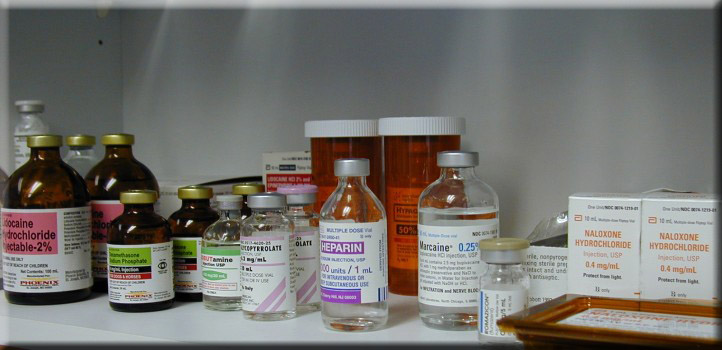 |
Veterinary Anesthesia & Analgesia Support Group |
| Practical Information for the Compassionate Veterinary Practitioner |
|
| HOME |
 |
||
|
|
||
| Alphabetical Drug Summaries | ||
| Dr. Bob Stein | ||
1) Sevoflurane
a) Classification
i) Fluorinated hydrocarbon ii) Chemical isomer of isoflurane b) General Information
i) A volatile liquid of low solubility that is minimally metabolized by the liver (1) Liver metabolism exceeds that of isoflurane ii) Its extremely low solubility provided for the quickest inductions, level adjustments, and recoveries of the currently used inhalant anesthetics (1) With the exception of patients experiencing extreme respiratory compromise sevoflurane is rarely of any advantage over isoflurane iii) MAC (1) Dog – 2.1 to 2.4% (2) Cats – 2.6% c) Advantages/Recommended use
i) This anesthetic agent is suitable for use with most veterinary patients ii) As with isoflurane, sevoflurane does not sensitize the heart to epinephrine induced arrhythmia iii) Along with isoflurane, an inhalant anesthetic of choice for patients with: (1) Liver disease (a) More liver metabolism than isoflurane (~5%) but no trifluoroacetic acid metabolites are produced (2) Intracranial disease (a) Less effect on CSF pressure compared to Halothane d) Cautionary Information
i) As with any inhalant anesthetic, cardiac and respiratory depression result as anesthetic concentrations are increased (1) Not all patients under sevoflurane will be able to maintain adequate blood pressures (2) Switching to an alternative maintenance agent may be necessary ii) Compound A (resulting from sevoflurane/sodasorb interaction) appears to be of little concern iii) Although sevoflurane is considered a relatively safe agent as pertains to staff exposure, we should all strive to minimize our exposure to this or any other inhalant agent e) Dosage Information
i) Routine use (1) Mask Induction (a) Start with 100% oxygen @ 3 liters/min for 3 - 5 minutes (i) Do not cover patients eyes (b) After 3 - 5 minutes of O2, start sevoflurane at 1 % (c) Increase by 1 % every 30 - 60 seconds until 3 % is reached (d) Then increase to 5 % - 7 % to complete induction (2) Induction following injectable agent (a) Initiate flow rates of 1.0 to 1 liter per minute at 3.5 % - 5.0 % (i) Reduce percentage as indicated by patients response (3) Maintenance (a) Once stable, reduce oxygen flow to 500 ml to 1 liter (i) The reservoir bag must remain full
1. If not, the flow rate must be increased and the machine must be examined for leaks at the earliest possible convenience (b) Remember that prior to surgical stimulation, a patient may appear adequately anesthetized only to show a dramatic response to stimulation (i) An experienced anesthetist should be able to anticipate and minimize this event (c) Effective analgesic & sedative premeds will significantly reduce the level of inhalant agent necessary for maintenance of a surgical plane of anesthesia f) Cost
i) high |
||
| Return to top of page | ||
| Questions or problems regarding this web site should be directed to DRSTEIN@VASG.ORG . Copyright © 2003 ASAH. All rights reserved. Last modified: February 16, 2011 . |
||